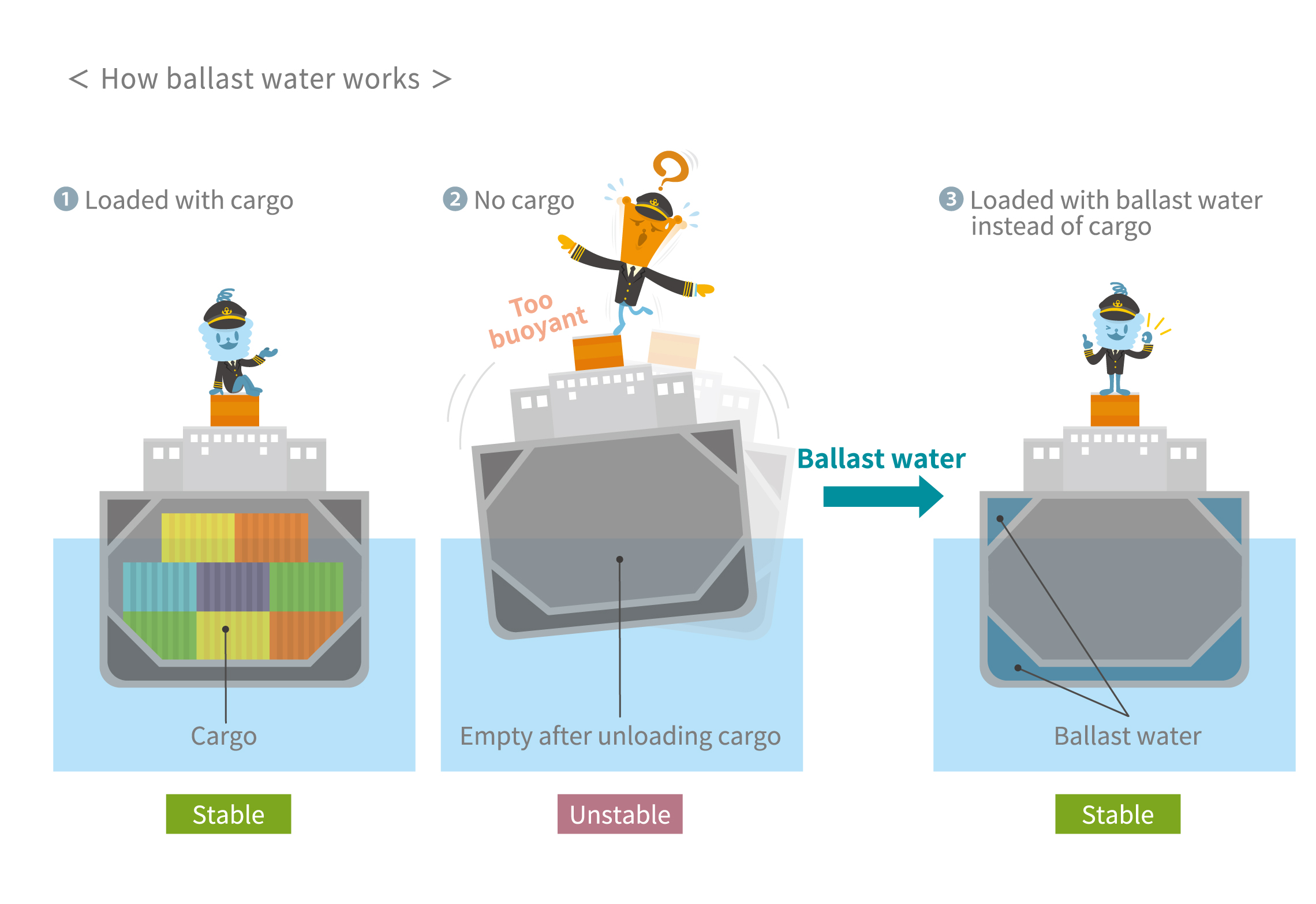The Wonders of Electromagnetism
EMC Filters: A Solution for Noise Arising from Advancing Technology

In a modern world that relies so much on electronics, problems arising from electromagnetic noise, from interference in radios and computers to malfunctions of robots, can present significant societal issues. Noise can infiltrate through different pathways and cause major problems with electronic devices. EMC (Electromagnetic Compatibility) filters, a category of components designed to suppress noise, play a vital role in ensuring the safe functioning of electronic equipment.
Wireless revolution: Before Guglielmo Marconi milestones
The first practical application of wireless communication is widely credited to Italian inventor Guglielmo Marconi. Inspired by the research on electromagnetic waves conducted by German physicist Heinrich Hertz, Marconi developed a radiotelegraph system in 1895 and later succeeded in radio communication across the English Channel in 1899 and the Pacific Ocean in 1901.
What is less known is that a Japanese engineer, Rintaro Shida, had already experimented with wireless communication in 1885, predating Marconi’s work on radiotelegraphy. Shida, who had studied under Lord Kelvin (William Thomson) in the United Kingdom and later became an electrical engineering professor at one of Tokyo University’s predecessor institutions, conducted an experiment using the surface of the Sumida River as a conductor instead of relying on electromagnetic waves. His work went on to make a significant contribution to the subsequent development of telecommunications in Japan. Shida passed away at the young age of 34 in 1890, unknowing about Marconi’s experiments.
Still, the Ministry of Communications, the Imperial Japanese Navy, and other institutions continued Shida’s research. By the early 20th century, Japan successfully brought independently developed wireless communication to practical use, building on the pioneering work of Shida.
Early radio transmitters relied on sparks
In the early days of radio transmitters, the method employed for emitting electromagnetic waves relied on discharge sparks. A switch called an interrupter toggled the direct current from a battery on and off, creating high-voltage discharge sparks that produced electromagnetic waves.
The receiver was technically challenging as it required a detector called a coherer, a glass tube filled with metallic powder. In its loose state, the powder exhibited high resistance, impeding the flow of direct current. When exposed to electromagnetic waves, which are a type of high-frequency alternating current, the powder particles coalesced, reducing the powder’s resistance and allowing the flow of direct current. The coherer leveraged this phenomenon to detect electromagnetic waves.
But there was a problem: once the coherer detected electromagnetic waves, the powder would remain coalesced and conductive. Initially, a mechanism similar to an electric bell’s hammer had to be created to continuously tap the glass tube and loosen the powder. Eventually, the Japanese Ministry of Communications invented and used a mercury-based coherer as a detector. The coherer was built with a rotating glass tube filled with oil and mercury instead of metallic powder.
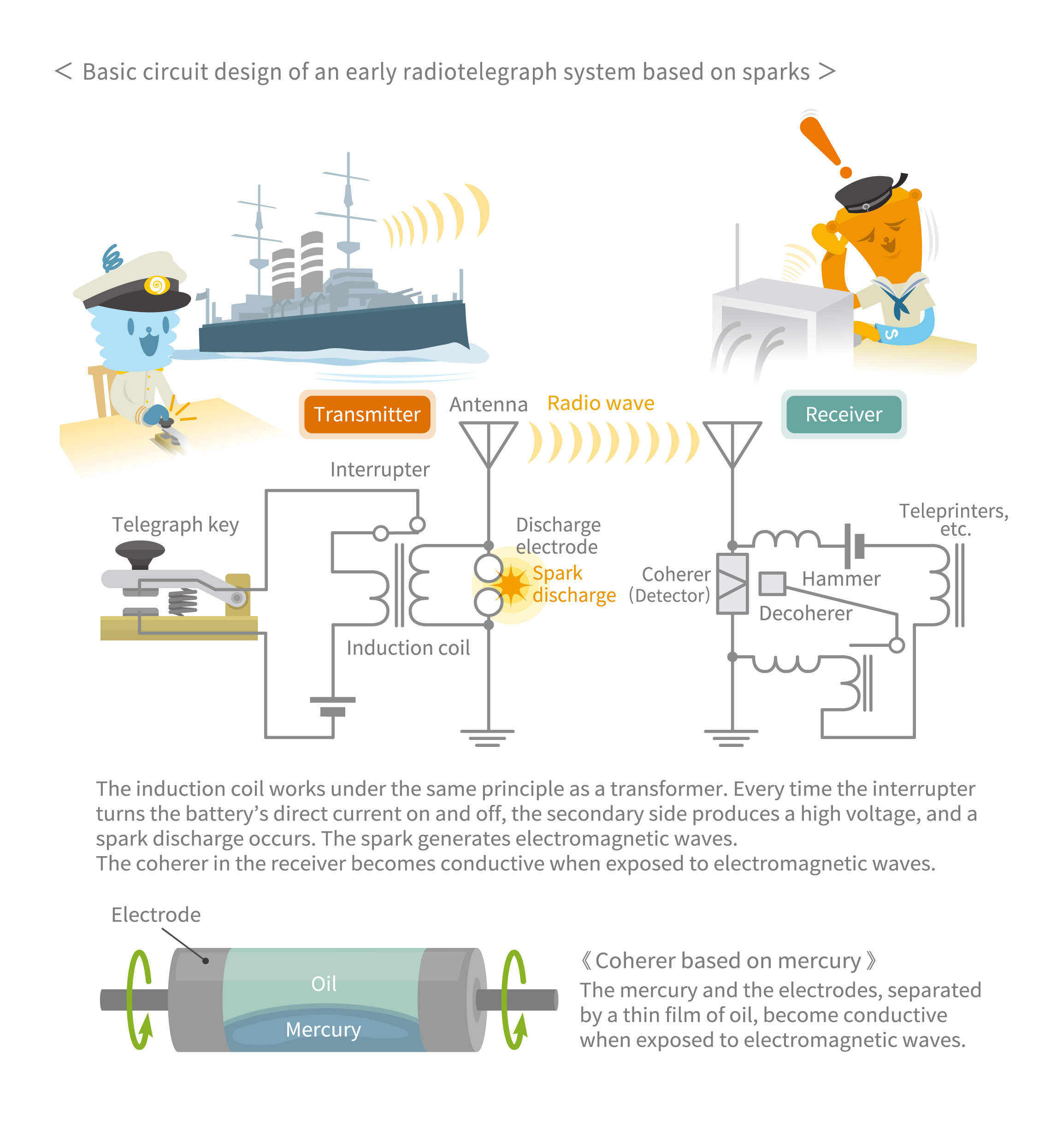
Telecommunication technology is inseparable from noise
When you ignite an electronic cigarette lighter near a radio, you often hear a sharp “thud” through the radio. This occurs because the discharge sparks generated by the ignition element emit noisy radio waves. This type of electromagnetic wave is referred to as white noise, which comprises a mixture of various frequency components. The hissing sound you hear between stations when you manually tune a radio is also a form of white noise. As interest in radiotelegraphy grew, this kind of interference quickly became a serious problem due to the wide frequency range used by spark-based radiotelegraphy systems.
The evolution of wireless communication technology accelerated with the introduction of vacuum tubes and the invention of tuned and filter circuits. In the latter half of the twentieth century, transistors, ICs, and LSIs replaced vacuum tubes, shifting the landscape from analog to digital. The progress of telecommunication technology over the past century has been simply remarkable. On the flip side, the increasing trends of high speed, high frequency, and low-voltage operation have made electronic devices more vulnerable to noise. Our environment is filled with various sources of noise, such as discharge sparks, pulses, and surges, which can disrupt the proper functioning of electronic devices.
In fact, during the microelectronics revolution in the 1980s, numerous incidents were attributed to noise, including industrial robots malfunctioning going haywire, game consoles causing disruption in train service, and automatic doors opening unexpectedly.
EMC measures for noise suppression
Today, electronic devices are equipped with mechanisms to reduce their susceptibility to external noise and to prevent them from becoming sources of noise. This approach is commonly known as EMC (Electromagnetic Compatibility).
Noise can be broadly categorized into radiated noise, which propagates through space, and conducted noise, which travels along power and signal lines. While radiated noise tends to weaken with distance, conducted noise, if left unaddressed, can penetrate without much attenuation. This demonstrates the importance of EMC filters in electronic devices that use AC power sources to prevent noise infiltration through power lines.
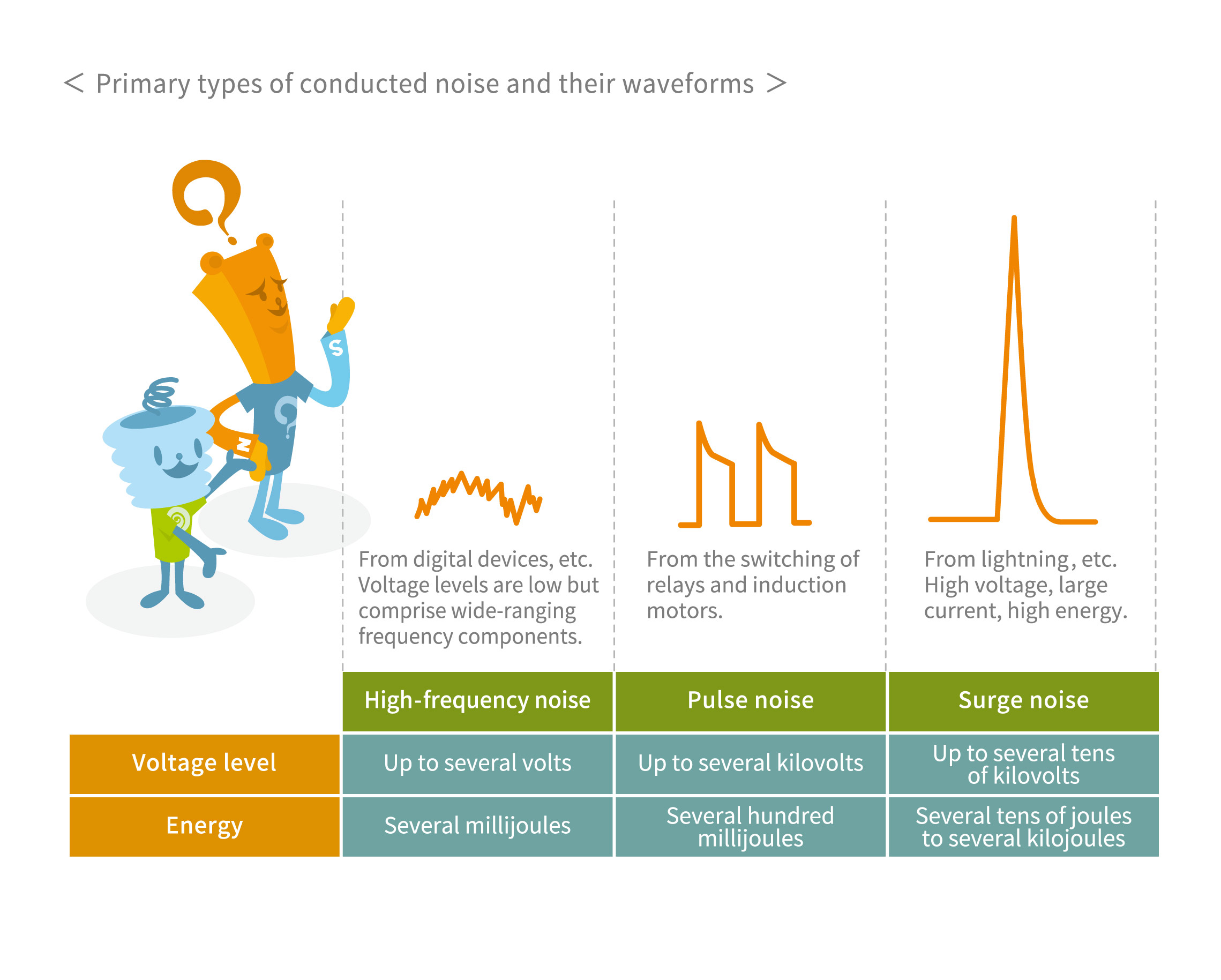
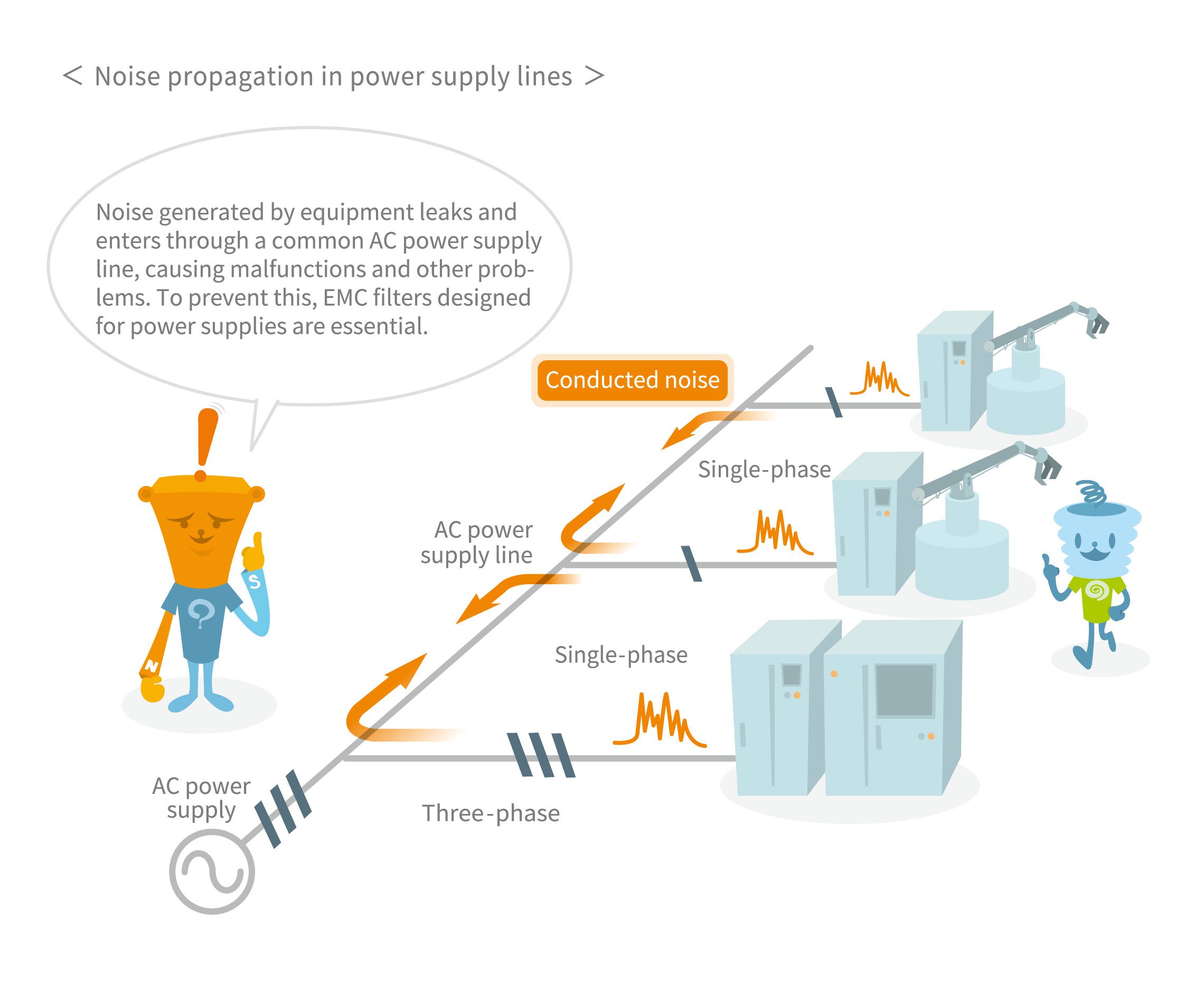
To learn more about EMC, see Introduction to Noise (EMC). Knowledge ranging from the basics of noise countermeasures to state-of-the-art solutions is presented in an approachable style.
The vital role of EMC filters designed for power supply lines
Conducted noise propagates in two ways: differential mode (also known as normal mode) and common mode. Differential mode noise current travels outward on one conductor and returns on another, like a signal current. Common mode noise infiltrates devices through paths, such as the floor, and flows in the same direction regardless of outward or return paths.
EMC filters designed for power supply lines combine capacitors and choke coils, and are used to suppress both differential mode and common mode noise. First, a capacitor is placed between the outbound and return conductors to remove differential noise (sometimes in conjunction with a choke). Second, a common mode filter (a choke) removes common mode noise. A common mode filter is a component with two wires wound around a core made of ferrite or amorphous materials. Since the two wires are wound in the same direction, common mode noise will generate magnetic fluxes in the same direction inside the core, strengthening the overall magnetic flux. This results in high inductance, and its braking effect blocks common mode noise from entering. Finally, a capacitor bypasses any residual common mode noise to ground.
Depending on the current rating, the frequency range of the noise, and the level of noise suppression required, the most suitable selection should be made from a wide range of EMC filters available for use in power supplies. Though often overlooked, the absence of EMC filters in a power supply can significantly deteriorate the noise environment, rendering electronic devices unable to function safely.
EMC filters in power supplies play crucial roles across a variety of fields, including NC (Numerical Control) machine tools, machining sensors, medical devices, and telecommunication and broadcast equipment. Even in familiar surroundings, a desktop computer’s rear AC power socket most likely contains a compact EMC filter. TDK’s EMC filters designed for power lines support the reliable operation of a vast range of electronic devices.
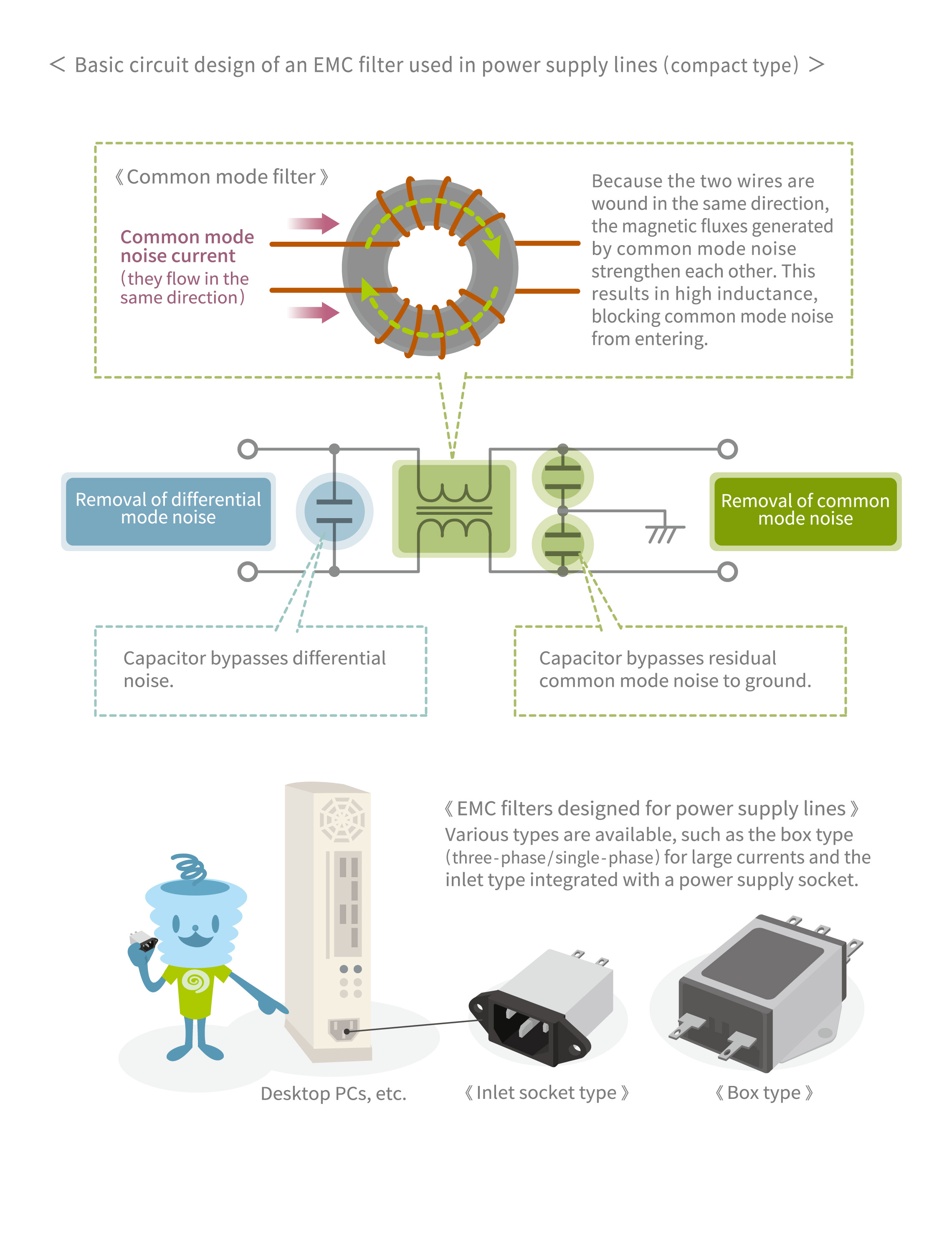
TDK is a comprehensive electronic components manufacturer leading the world in magnetic technology



